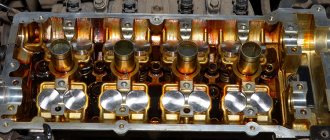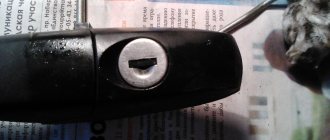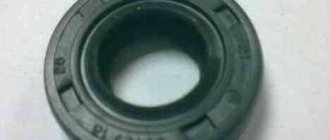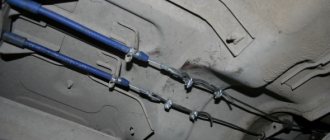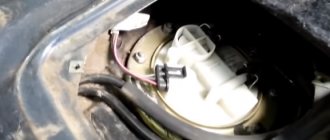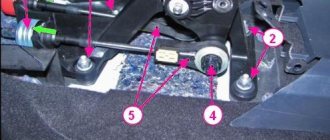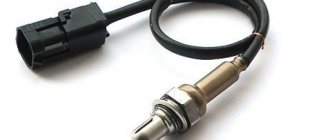A hydraulic compensator is a device that is used in modern engines to automatically adjust valve clearances. This element has an important function in the operation of the gas distribution unit, which controls the supply of the working mixture to the combustion chambers of the engine, as well as the removal of exhaust gases. In order for the engine to operate in normal mode, the above-mentioned unit must promptly open and close the valves of the power unit.
It is worth recalling that in order to maintain the required valve timing, the open valve has a certain clearance. In cars of the Lada Priora family (VAZ 2170-72) with engine 21126, 16 valves are used, the clearance of which is adjusted by hydraulic compensators (HC). Since this part is subject to increased wear, in this article we will consider the issues of replacing the main valves, as well as the reasons why knocking occurs in them.
This is what the new hydraulic compensators look like on the Priora 16 cl.
Hydraulic compensator operating principle and design
Hydraulic compensators of the Lada Priora car
Hydraulic lifters are located in the engine, right between the valves and the camshaft. These are metal cylinders and each of them has a plunger inside. When the engine is running, the shaft cam presses on the bottom of the cylinder and the hydraulic compensator begins to move down. At the same time, the plunger located inside it begins to press on the valve, causing the valve to open. Thanks to this design, the car owner does not need to measure the valve clearances every time during routine engine maintenance, since the size of the gap is now determined by the oil pumped under high pressure into the space under the plungers. The more oil is supplied there, the higher its pressure and the greater the valve clearance.
Everything should be nearby, don’t start without preparation
Lada Priora can serve as an example to consider the replacement process. To avoid unpleasant surprises, any work must be planned and everything necessary must be prepared. In our case we will need:
- Gasket Maker - sealant (anaerobic);
- camshaft plugs and seals;
- 16 INA compensators.
Let's start by disconnecting the battery minus. Then we dismantle the air filter, throttle cables, wires that will interfere with manipulation, injector ignition coils and intake manifold.
Replacing hydraulic compensators on a Priora is complicated by the fact that the manifold mounting bolt is located under the generator.
To get to the hydraulic compensators:
- The generator belt is removed, the generator itself is freed from the mounting bolts and carefully moved to the radiator. Using a wrench with a rotary head, the manifold mounting bolt is unscrewed.
- The ramp with nozzles is dismantled and the air conditioning pipes are disconnected (if equipped).
- The collector is dismantled. First, we lift its left edge and then the entire part, and then we move it to the left.
- The valve cover is removed using a screwdriver inserted into the technological grooves.
- Next, the timing belt is removed, the pulleys, camshaft bed and the shafts themselves are dismantled.
All compensators are open to view, among them it is necessary to identify the faulty ones. This is done by pushing. Defective ones will sag without much effort. The hydraulic compensators are removed using a magnet. The entire set must be replaced, since they are used in similar conditions and wear should be approximately the same.
In principle, on 16-cylinder VAZ internal combustion engines, this operation does not have any fundamental differences. Replacement of VAZ 2112 (VAZ 2110) hydraulic compensators is carried out in the same sequence using the same hydraulic compensators and tools. The difference in details is determined by the characteristics of a particular engine installed on the car.
The above modifications have engines with a camshaft located on top. But there are also those in which it is located below. In this case, the rocker (rocker arm) acts on the heel of the automobile valve. Replacing hydraulic compensators on a Chevrolet Niva (where the timing belt is designed exactly like this) will be technologically different from what is described, and the “hydraulics” there are of a different type.
Malfunctions and their causes
As mentioned above, the design of hydraulic compensators is extremely simple. But even such simple parts fail. There are three main signs that indicate that something is wrong with the hydraulic compensators:
- While the engine is running, a quick knocking noise is clearly audible.
- Engine power drops significantly, especially at high speeds.
- The engine runs rough, even at idle.
If any of these signs are observed, then it’s time to change the hydraulic compensators. The main problem with these parts is that they are extremely sensitive to the quality of the engine oil. Sometimes it doesn’t even get to the point of replacing hydraulic compensators. The car owner simply drains the old oil, fills in new oil (after flushing the engine) and the knocking disappears. If the problem does not go away, it means that there is mechanical wear of the hydraulic compensators (usually this occurs due to the so-called metal fatigue).
Replacing hydraulic compensators on the 21126 Priora engine 16 valves
First of all, you need to buy new hydraulic compensators for the Priora engine. It is important to take into account that if one main valve fails, then everything should be changed. To carry out the work you will need the following tools.
Tool
- Set of wrenches with socket heads;
- Screwdrivers;
- New set of compensators;
- New cylinder head cover gasket;
- Camshaft seals;
- Sealant;
- Magnet (optional).
Which company should I purchase spare parts for replacement?
Owners of Priora 16, who have already encountered the replacement of these components, recommend installing INA hydraulic compensators. The pushers from the VAZ 2112 have also proven themselves; they are produced by. If these options are not available in the store, then take the standard set for Lada Priora. Another important question is how much these parts cost. We answer: 2500-3500 rubles, depending on the manufacturer. Now you know which hydraulic compensators are best to install, all that remains is to do the work.
It just so happens that the domestic auto industry has a special status among owners of wheeled vehicles. On the one hand, everyone never tires of scolding it for its poor build quality, on the other hand, there is no doubt about the maintainability and unpretentiousness of cars produced in Russia.
The Lada Priora, which replaced the VAZ-2110, immediately fell in love with many car owners, occupying a niche that is not very expensive in the price of the domestic sedan and hatchback. And something that is actively driven begins to break down, and Priora is no exception. One of the most common complaints from car enthusiasts is an extraneous knock in the engine, starting from 15-20 thousand kilometers.
In most cases, in the absence of extreme driving conditions, the cause of knocking is a malfunction of the hydraulic compensators of the gas distribution mechanism (GRM). Let's figure out whether you need to contact a car service or whether repairs done yourself are enough.
Hydraulic compensators are used to adjust the valve clearance. On simpler engines, the clearances had to be adjusted manually at each service. On the VAZ Priora this function is performed by hydraulic compensators. They are metal cylinders with a plunger inside, and are placed between the valve and the camshaft cam. Inside the hydraulic compensators there is motor oil supplied there under pressure.
Assembly nuances
After replacing 16 hydraulic compensators, everything must be restored to its original form. The most important operations in order:
- We clean and degrease the camshafts and seats of the bed and valve cover, both on the parts and on the engine.
- We change the seals, plugs and put both shafts in place. The inlet has a special belt, which is not present on the outlet. This is its distinctive feature.
- Apply Gasket sealant to the mounting location of the camshaft bed and mount it (no gasket required).
- We treat the fit for the valve cover with sealant and mount it (no gasket required).
- We install injectors, condenser tubes, mount the manifold, generator, its belt, pulleys and timing belt.
- We restore the operation of the throttle valve, filter and connect all the wires.
Replacing hydraulic lifters sometimes results in the engine not starting due to lack of compression. As a rule, hydraulic valves are installed oil-filled and it may happen that due to the incompressibility of compensators, some valves will be open. To avoid this, it is necessary to tighten them with a clamp before installation.
How the system works
Hydraulic compensators are an integral attribute for many modern car models. Previously, valve stroke had to be adjusted manually, which was done on AvtoVAZ engines in earlier cars.
The hydraulic compensator is designed quite simply. It looks like a cylinder, inside of which a plunger is installed. Let's consider the principle of its operation step by step.
- When starting the engine, the device is affected by the camshaft cam.
- Under the action of the cam, the compensator moves lower, after which its plunger exerts pressure on the valve.
- Under the influence of pressure, the valve opens, but strictly to a certain height.
The operation of the devices is adjusted using ordinary oil. It enters the space located under the plunger, and the greater its pressure, the greater the load on the plunger itself.
Accordingly, the valve clearance is adjusted automatically, taking into account the oil level.
We are taking action
So, the hydraulic compensators are knocking, what should you do? Do not panic. Such a phenomenon has not yet brought the car to exclusion from the transportation process.
The functioning of this important part is directly related to the lubrication system. If the hydraulic lifters are knocking, the likelihood that the oil has lost its original characteristics is quite high.
Don't immediately think about disassembling the engine. First of all, to eliminate knocking, change the oil and filter. After replacement, when starting, do not flinch from the knocking of the hydraulic compensators; during the process of draining the oil, it will leave them, and the plungers will fill when the oil pump starts.
If this does not help, then you need to find out which hydraulic compensator is knocking. The question arises, how to determine the one that needs to be changed? For example, the VAZ 2112 has 16 valves, how can you find out which one is not functioning?
To do this, you need to position the camshaft cam (rocker arm) so that it does not interfere and try to press the compensator with a drift. The serviceable one will press through if significant force is applied, the faulty one will go down easily. It needs to be removed.
How to check hydraulic compensators without disassembling? The faulty one can also be detected with the engine running.
After discovering faulty parts, some car owners remove them in order to remove contaminants from the plunger by disassembling and washing. Others go to remove and replace them. Often, after these manipulations it is possible to eliminate the knocking only for a while.
Analysis and analysis of the frequency of repair of these components suggests that their wear and operating conditions are approximately the same, and therefore their condition is also the same. Therefore, it is recommended to replace hydraulic compensators as a set.
In general, I have heard a lot from this topic.
I’ll describe the problem again: In general, even when I bought the car, in July of this year (from my hands) I heard such a weak sound of hydraulic compensators knocking, the former owner immediately gave me a set of new hydraulics, saying they’ll change it. Now the sound has become quite strong, they knock both cold and hot. I changed all the consumables - it didn’t help, the oil (it was Kansler 10w-40, now I filled it with Mobil 5w-40) and the oil filter also changed (the replacement was on October 11). Today I decided to check the oil (before that, I, such a fool, had not looked at it at all) and saw that just half of the dipstick was missing.
In the previous topic, people's opinions were divided, the majority believed that the piston was knocking - supposedly the timing belt was broken at some point and the valves were bent, and only the valves were changed, but the piston was not changed, and now they say it is knocking. Then why didn't he knock earlier? Or is this how it should be? The other half is still sure that these are hydraulic compensators, they say, when the piston knocks, it makes a duller and more frequent sound.
How to identify a faulty hydraulic compensator
Before work, analyze the wear of all pushers, otherwise the case where someone changed the working compensators will repeat. The search for knocking hydraulic compensators of Priora 16 valves involves conducting several experiments or tests. It is basically calculated that Priora hydraulic pushers operate for 100 thousand kilometers.
These parts may rattle when starting a cold engine, and then continue to make noise even when the engine warms up. Knowing about this malfunction, follow these steps to identify faulty Priora hydraulic pushers:
- Check the main valve ball valve. If it is worn out, then nothing can be done - the hydraulic valve will have to be changed and a new part installed in its place.
- The internal cavity of the pusher is contaminated with used grease or oil. If the cases are not critical, you can wash the hydraulics and then coat everything inside with a good oil composition.
- A couple of plungers are worn out - these are two small cylinders. The part cannot be repaired, so it will also have to be replaced.
These signs appear when the hydraulic valves knock while the engine is cold, as well as after it has warmed up, but they quiet down at high speeds. There is another way that will help identify faulty hydraulic pushers. It touches the spring - it is responsible for ensuring that the small parts return to their place whenever the valve needs to be returned back, closing the hole.
In order to see how the HA springs work, press each small part through a soft cloth. At the same time, try to place your finger so that it completely covers its upper part. A well-functioning hydraulic compensator should return when pressed. If it remains at the bottom, this means that the spring no longer works, and it’s time to change the part.
By the way, let’s talk about why Priora hydraulics can knock after repair work:
- If new parts make a sound, they are still falling into place - after a couple of engine starts this sound will not be there.
- If the knocking noise appears after changing the oil, the reason is poor-quality oil or a bad/worn out filter.
- Finally, after the car has been left alone for a long time, this piercing sound may also appear. Over time it will disappear. It's just that the oil has drained from the working chambers, and they need to be filled before starting everyday operation without knocking, as well as other signs of malfunctions that can be scary.
Knocks when the engine is cold, what to do
Please note that by starting a cold engine, you are subjecting it to a significant test. This does not mean at all that you cannot run it in frosty weather. It’s just that all the insides harden, the movements of parts are constrained, even “wooden”. They need to warm up in order to return to normal - then the gaps and other parameters will return to operating parameters.
Realizing the severity of the work that the engine does in the cold, we can talk in detail about the reasons why the hydraulic pushers of a cold sixteen-valve Priora engine knock:
- The engine oil life is coming to an end. The oil is of poor quality. The oil is contaminated with engine operating products.
- The viscosity of the engine oil is not suitable for the engine. If it is too soft, the hydraulics will literally “break out” of their positions, which will damage their springs.
- If the oil is too thick, the hydraulic boosters will physically be unable to push the valve.
- The oil system is clogged. If the cross-section through which the valve passes is reduced, the pressure inside the hydraulic tappet decreases and it produces less power during operation.
- The main oil line does not support high pressure. This can be recognized by the burning light indicating the oil level on the dashboard.
- The plunger inside the main valve is jammed. This can happen due to carbon deposits accumulated inside.
- The plunger is worn out. If the check valve leaks, there can be no talk of any high pressure that the hydraulic fluid exerts on the valve.
The knock does not go away or appears on a hot engine
When the engine temperature has gradually risen to operating temperature, the knocking noise may remain. On the contrary, it can suddenly appear. The cause could be any problem typical of knocking on a cold Priora engine. But due to the specifics, two more reasons can be named that cause the knocking of hydraulic pushers in warm Priora engines:
- High or low oil level. When there is too much oil, it doesn't provide room to work. If it is too small, there will not be enough pressure to push the valve.
- The hydraulic wells have expanded due to an overheated engine. Small parts will “walk” in them, and then even go down with a figure eight. Because of this, all the force that they could exert on the valve will be extinguished. Cool down the engine.
Source
Sequence of actions on Lada Priora
- Both terminals are removed from the battery.
- The wires on the injectors and on the ignition coil are disconnected, the cable is removed from the throttle, the air filter and all other wires that prevent access to the engine intake manifold are removed.
- Before removing the manifold, you will have to remove the belt from the generator, then unscrew its mounting bolt. After this, the generator can be moved to the side and you can get to one of the intake manifold mounting bolts (there is no other way to get to this bolt).
- The next step is to remove the ramp and fuel injectors (if the car has air conditioning, you will also have to remove its hoses so that they do not interfere).
- All other manifold mounting bolts are unscrewed, after which it is removed.
The valve cover is unscrewed with a 12 mm socket wrench.
- Now you can remove the valve cover, timing pulleys and camshafts.
Removing a previously unscrewed valve cover
- Since we now have access to the hydraulic compensators, all that remains is to replace them with new ones (we should also change the seals on the camshafts and the sealant on the valve cover).
After removing the cover, the camshafts are removed
Worn hydraulic compensators are removed from their sockets
- After this, the above components are reassembled. The instructions below are suitable for cars with 16 valves.
Replacing hydraulic compensators on a VAZ-2112 is not so easy, but you can do it yourself. Of course, this will require time and effort. The choice of product should also be taken quite seriously, because the resource of use depends on the quality.
Checking the cylinder head check valve
When disassembling the pusher, you will come across a cylinder head check valve, which contains a ball with a spring. Inspect the cylinder head check valve; if these elements are damaged, then only replacing the pusher will help. The cylinder head check valve along with its components can be replaced entirely, but these parts cannot be found in every car store. They are not in demand, as it rarely fails.
When you inspect the check valve, check whether it is dry or not. If the hydraulic compensator is working properly, then the check valve should be in oil. You can pour lubricant into it and see why the oil leaves.
